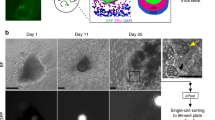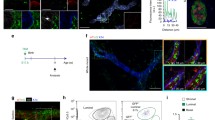Abstract
CD24 is expressed on mammary stem cells and is used as a marker for their isolation, yet its function in the mammary gland still needs to be examined. Here we show that CD24 is expressed throughout the luminal epithelial cell layer, but only weakly in myoepithelial cells. During lactation, CD24 expression was suppressed within alveoli, but upregulated post-lactation, returning to a pre-pregnant spatial distribution. CD24-deficient mice exhibited an accelerated mammary gland ductal extension during puberty and an enhanced branching morphogenesis, resulting in increased furcation in the ductal structure. CD24−/− mammary epithelial cells were able to completely repopulate cleared mammary fat pads and to give rise to fully functional mammary glands. Together, these data suggest that while CD24 is expressed in mammary epithelium compartments thought to contain stem cells, CD24 is not a major regulator of mammary stem/progenitor cell function, but rather plays a role in governing branching morphogenesis.







Similar content being viewed by others
References
Smalley M, Ashworth A (2003) Stem cells and breast cancer: a field in transit. Nat Rev Cancer 3:832–844
Williams JM, Daniel CW (1983) Mammary ductal elongation: differentiation of myoepithelium and basal lamina during branching morphogenesis. Dev Biol 97:274–290
Radnor CJ (1972) Myoepithelial cell differentiation in rat mammary glands. J Anat 111:381–398
Taylor-Papadimitriou J, Lane EB (1987) Keratin expression in the mammary gland. In: Neville MC, Daniels C (eds) The mammary gland: development, regulation and function. Plenum Publishing Co., New York, pp 181–215
Hennighausen L, Robinson GW (2005) Information networks in the mammary gland. Nat Rev Mol Cell Biol 6:715–725
Daniel CW, De Ome KB, Young JT, Blair PB, Faulkin LJ Jr (1968) The in vivo life span of normal and preneoplastic mouse mammary glands: a serial transplantation study. Proc Natl Acad Sci USA 61:53–60
Visvader JE (2009) Keeping abreast of the mammary epithelial hierarchy and breast tumorigenesis. Genes Dev 23:2563–2577
Shackleton M, Vaillant F, Simpson KJ, Stingl J, Smyth GK, Asselin-Labat ML, Wu L, Lindeman GJ, Visvader JE (2006) Generation of a functional mammary gland from a single stem cell. Nature 439:84–88
Stingl J, Eirew P, Ricketson I, Shackleton M, Vaillant F, Choi D, Li HI, Eaves CJ (2006) Purification and unique properties of mammary epithelial stem cells. Nature 439:993–997
Deugnier MA, Faraldo MM, Teuliere J, Thiery JP, Medina D, Glukhova MA (2006) Isolation of mouse mammary epithelial progenitor cells with basal characteristics from the Comma-Dbeta cell line. Dev Biol 293:414–425
Sleeman KE, Kendrick H, Robertson D, Isacke CM, Ashworth A, Smalley MJ (2007) Dissociation of estrogen receptor expression and in vivo stem cell activity in the mammary gland. J Cell Biol 176:19–26
Kristiansen G, Sammar M, Altevogt P (2004) Tumour biological aspects of CD24, a mucin-like adhesion molecule. J Mol Histol 35:255–262
Tone M, Nolan KF, Walsh LA, Tone Y, Thompson SA, Waldmann H (1999) Structure and chromosomal location of mouse and human CD52 genes. Biochim Biophys Acta 1446:334–340
Rietze RL, Valcanis H, Brooker GF, Thomas T, Voss AK, Bartlett PF (2001) Purification of a pluripotent neural stem cell from the adult mouse brain. Nature 412:736–739
Lawson DA, Xin L, Lukacs RU, Cheng D, Witte ON (2007) Isolation and functional characterization of murine prostate stem cells. Proc Natl Acad Sci USA 104:181–186
Sagrinati C, Netti GS, Mazzinghi B, Lazzeri E, Liotta F, Frosali F, Ronconi E, Meini C, Gacci M, Squecco R, Carini M, Gesualdo L, Francini F, Maggi E, Annunziato F, Lasagni L, Serio M, Romagnani S, Romagnani P (2006) Isolation and characterization of multipotent progenitor cells from the Bowman’s capsule of adult human kidneys. J Am Soc Nephrol 17:2443–2456
Nielsen PJ, Lorenz B, Muller AM, Wenger RH, Brombacher F, Simon M, von der Weid T, Langhorne WJ, Mossmann H, Kohler G (1997) Altered erythrocytes and a leaky block in B-cell development in CD24/HSA-deficient mice. Blood 89:1058–1067
Li O, Zheng P, Liu Y (2004) CD24 expression on T cells is required for optimal T cell proliferation in lymphopenic host. J Exp Med 200:1083–1089
Shewan D, Calaora V, Nielsen P, Cohen J, Rougon G, Moreau H (1996) mCD24, a glycoprotein transiently expressed by neurons, is an inhibitor of neurite outgrowth. J Neurosci 16:2624–2634
Kleene R, Yang H, Kutsche M, Schachner M (2001) The neural recognition molecule L1 is a sialic acid-binding lectin for CD24, which induces promotion and inhibition of neurite outgrowth. J Biol Chem 276:21656–21663
Belvindrah R, Rougon G, Chazal G (2002) Increased neurogenesis in adult mCD24-deficient mice. J Neurosci 22:3594–3607
Nieoullon V, Belvindrah R, Rougon G, Chazal G (2005) mCD24 regulates proliferation of neuronal committed precursors in the subventricular zone. Mol Cell Neurosci 28:462–474
Jevsek M, Jaworski A, Polo-Parada L, Kim N, Fan J, Landmesser LT, Burden SJ (2006) CD24 is expressed by myofiber synaptic nuclei and regulates synaptic transmission. Proc Natl Acad Sci USA 103:6374–6379
Chen GY, Tang J, Zheng P, Liu Y (2009) CD24 and Siglec-10 selectively repress tissue damage-induced immune responses. Science 323:1722–1725
Kristiansen G, Denkert C, Schluns K, Dahl E, Pilarsky C, Hauptmann S (2002) CD24 is expressed in ovarian cancer and is a new independent prognostic marker of patient survival. Am J Pathol 161:1215–1221
Young LJT (2000) The cleared mammary fat pad and the transplantation of mammary gland morphological structures and cells. In: Ip MM and Ash BB (eds) Methods in mammary gland biology and breast cancer research. Kluwer Academic/Plenum Publishers, New York, pp 67–74
Hofmann M, Fieber C, Assmann V, Gottlicher M, Sleeman J, Plug R, Howells N, von Stein O, Ponta H, Herrlich P (1998) Identification of IHABP, a 95 kDa intracellular hyaluronate binding protein. J Cell Sci 111:1673–1684
Hebbard L, Steffen A, Zawadzki V, Fieber C, Howells N, Moll J, Ponta H, Hofmann M, Sleeman J (2000) CD44 expression and regulation during mammary gland development and function. J Cell Sci 113:2619–2630
Jones C, Mackay A, Grigoriadis A, Cossu A, Reis-Filho JS, Fulford L, Dexter T, Davies S, Bulmer K, Ford E, Parry S, Budroni M, Palmieri G, Neville AM, O’Hare MJ, Lakhani SR (2004) Expression profiling of purified normal human luminal and myoepithelial breast cells: identification of novel prognostic markers for breast cancer. Cancer Res 64:3037–3045
Sternlicht MD (2006) Key stages in mammary gland development: the cues that regulate ductal branching morphogenesis. Breast Cancer Res 8:201
Daniel CW, Robinson S, Silberstein GB (1996) The role of TGF-beta in patterning and growth of the mammary ductal tree. J Mammary Gland Biol Neoplasia 1:331–341
Ewan KB, Shyamala G, Ravani SA, Tang Y, Akhurst R, Wakefield L, Barcellos-Hoff MH (2002) Latent transforming growth factor-beta activation in mammary gland: regulation by ovarian hormones affects ductal and alveolar proliferation. Am J Pathol 160:2081–2093
Nelson CM, Vanduijn MM, Inman JL, Fletcher DA, Bissell MJ (2006) Tissue geometry determines sites of mammary branching morphogenesis in organotypic cultures. Science 314:298–300
Lu P, Ewald A, Martin G, Werb Z (2005) Essential function of FGF signalling pathway during branching morphogenesis of the mammary gland. Dev Biol 283:680–681
Schabath H, Runz S, Joumaa S, Altevogt P (2006) CD24 affects CXCR4 function in pre-B lymphocytes and breast carcinoma cells. J Cell Sci 119:314–325
Hahne M, Wenger RH, Vestweber D, Nielsen PJ (1994) The heat-stable antigen can alter very late antigen 4-mediated adhesion. J Exp Med 179:1391–1395
Baumann P, Cremers N, Kroese F, Orend G, Chiquet-Ehrismann R, Uede T, Yagita H, Sleeman JP (2005) CD24 expression causes the acquisition of multiple cellular properties associated with tumor growth and metastasis. Cancer Res 65:10783–10793
Klinowska TC, Soriano JV, Edwards GM, Oliver JM, Valentijn AJ, Montesano R, Streuli CH (1999) Laminin and beta1 integrins are crucial for normal mammary gland development in the mouse. Dev Biol 215:13–32
Naylor MJ, Li N, Cheung J, Lowe ET, Lambert E, Marlow R, Wang P, Schatzmann F, Wintermantel T, Schuetz G, Clarke AR, Mueller U, Hynes NE, Streuli CH (2005) Ablation of beta1 integrin in mammary epithelium reveals a key role for integrin in glandular morphogenesis and differentiation. J Cell Biol 171:717–728
Taddei I, Deugnier MA, Faraldo MM, Petit V, Bouvard D, Medina D, Fassler R, Thiery JP, Glukhova MA (2008) Beta1 integrin deletion from the basal compartment of the mammary epithelium affects stem cells. Nat Cell Biol 10:716–722
Sleeman KE, Kendrick H, Ashworth A, Isacke CM, Smalley MJ (2006) CD24 staining of mouse mammary gland cells defines luminal epithelial, myoepithelial/basal and non-epithelial cells. Breast Cancer Res 8:R7
Nieoullon V, Belvindrah R, Rougon G, Chazal G (2007) Mouse CD24 is required for homeostatic cell renewal. Cell Tissue Res 329:457–467
Kristiansen G, Winzer KJ, Mayordomo E, Bellach J, Schluns K, Denkert C, Dahl E, Pilarsky C, Altevogt P, Guski H, Dietel M (2003) CD24 expression is a new prognostic marker in breast cancer. Clin Cancer Res 9:4906–4913
Aigner S, Ramos CL, Hafezi-Moghadam A, Lawrence MB, Friederichs J, Altevogt P, Ley K (1998) CD24 mediates rolling of breast carcinoma cells on P-selectin. Faseb J 12:1241–1251
Friederichs J, Zeller Y, Hafezi-Moghadam A, Grone HJ, Ley K, Altevogt P (2000) The CD24/P-selectin binding pathway initiates lung arrest of human A125 adenocarcinoma cells. Cancer Res 60:6714–6722
Lanigan F, O’Connor D, Martin F, Gallagher WM (2007) Molecular links between mammary gland development and breast cancer. Cell Mol Life Sci 64:3159–3184
Bierie B, Moses HL (2006) Tumour microenvironment: TGFbeta: the molecular Jekyll and Hyde of cancer. Nat Rev Cancer 6:506–520
Siegel PM, Massague J (2003) Cytostatic and apoptotic actions of TGF-beta in homeostasis and cancer. Nat Rev Cancer 3:807–821
Acknowledgments
We thank Norma Howells and Selma Huber for excellent technical assistance with the animal experiments, Diana Plaumann and Stefanie Dukowic-Schulze for their outstanding practical help, and Marina Glukhova for her support and advice. This work was supported by grants from the European Union (FP6 STREP project BRECOSM, contract no. LSHC-CT-2004-503224) and the German National Genome Research Network (NGFN2). M.A.D is “chargée de recherche” at the “Institut de la Santé et de la Recherche Médicale”.
Author information
Authors and Affiliations
Corresponding author
Electronic supplementary material
Below is the link to the electronic supplementary material.
18_2010_342_MOESM1_ESM.tif
Supplementary Figure 1. CD24 staining at various time points of mammary gland development. The ages of the mice from which the glands were taken are indicated. Immunostaining of CD24 (green fluorescence), smooth muscle actin (red fluorescence) and DAPI staining of nuclei (blue fluorescence) is shown (TIFF 23271 kb)
18_2010_342_MOESM2_ESM.tif
Supplementary Figure 2. A. CD24 -/- gland stained with anti-CD24 M1/69 antibody (green) and anti-SMA antibody (red). Nuclei are stained with DAPI (blue). The arrows indicate staining of periductal structures in the stroma, indicating that the M1/69 antibody can weakly stain non-CD24 epitopes. B. Virgin CD24 +/+ gland stained with an isotype control for the CD24 M1/69 antibody. C. Section of murine ovary immunostained for CD24 (green fluorescence), smooth muscle actin (red fluorescence) and DAPI staining of nuclei (blue fluorescence). These data show an absence of CD24 expression in ovarian tissue. D-F. Virgin CD24 +/+ gland double stained with CD24 (green fluorescence) and CD45 (red fluorescence), indicating that CD24 signals in stromal cells can be due to CD45-positive cells from the hemapoetic system (TIFF 15451 kb)
18_2010_342_MOESM3_ESM.tif
Supplementary Figure 3. Proliferation rates in mammary epithelial cells from 6-week-old CD24 +/+ and CD24 -/- mice. A. Representative section of mammary gland stained with Ki-67 antibody (brown nuclear stain). The sections were counterstained with hematoxylin. B. Quantification of Ki-67 staining. The number of animals analyzed (n) is indicated. For quantification of proliferation, 8–10 independent fields from each histological section were photographed (Axiovision microscope, Zeiss; 20× objective). A minimum of 2,600 mammary epithelial cells were evaluated per animal. The number of Ki-67-positive mammary epithelial nuclei versus the total number of mammary epithelial nuclei was counted and expressed as %. The mean and standard error are presented. Statistical significance was calculated using an unpaired two-sided Student’s t-test (TIFF 6197 kb)
Rights and permissions
About this article
Cite this article
Cremers, N., Deugnier, MA. & Sleeman, J. Loss of CD24 expression promotes ductal branching in the murine mammary gland. Cell. Mol. Life Sci. 67, 2311–2322 (2010). https://doi.org/10.1007/s00018-010-0342-6
Received:
Revised:
Accepted:
Published:
Issue Date:
DOI: https://doi.org/10.1007/s00018-010-0342-6




